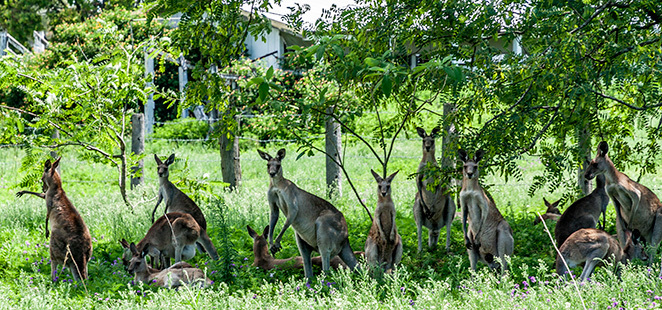
Wacol is widely recognised today as home to Brisbane’s largest urban population of Eastern Grey Kangaroos. More than a thousand animals roam freely across the bushland and adjoining green corridors, forming one of the most significant kangaroo mobs found so close to the centre of any Australian capital city. Their presence has become one of the distinctive natural features of the area – but this landscape also carries an important human history.
During the Second World War, Camp Columbia in Wacol, the major Allied staging camp for the South-West Pacific campaign, lay directly within the area where these kangaroos lived. The camp was occupied by American forces, the Netherlands East Indies government-in-exile, and numerous Australian military units. Its infrastructure included roads, workshops, sewerage facilities, accommodation areas, and training grounds.
After the war, the story of the site took another remarkable turn. Large parts of Camp Columbia became Queensland’s largest post-war migration centre, hosting thousands of newly arrived migrants from Europe and elsewhere. For many of them, just like the Allied servicemen before them, the kangaroo was an animal they had only heard about. Encountering kangaroos around the camp buildings, the bush tracks, or even near their accommodation huts would have been an unforgettable experience. These impressions may well have found their way into letters, diaries, and early family stories of migration to Australia.
This unusual combination of intact natural habitat, wartime heritage, and migration history makes Camp Columbia a place where environmental and human stories intersect in unexpected ways. It also raises an intriguing research question: what interactions occurred between servicemen, migrants, and the kangaroos that lived in the area during the 1940s and 1950s?
The Camp Columbia Heritage Association would like to explore this overlooked aspect of local history. We are particularly interested in:
- recollections passed down through families
- letters, diaries, or photographs from American, Dutch, or Australian service personnel
- memories from post-war migrants who stayed at the Wacol migration camp
- stories from residents or workers in the Wacol–Richlands area
- accounts from former National Servicemen who trained near the area in the post-war years
Any information, no matter how small, could help us reconstruct this unique connection between wildlife, wartime life, and early migration experiences at Camp Columbia.
If you have a story to share or know someone who might, we would love to hear from you. Please contact us via our website or email and help us preserve yet another chapter of Brisbane’s wartime and post-war heritage.
See also: Camp Columbia has new residents
